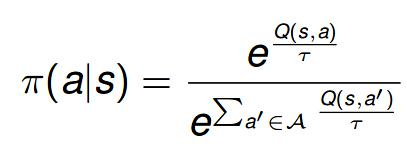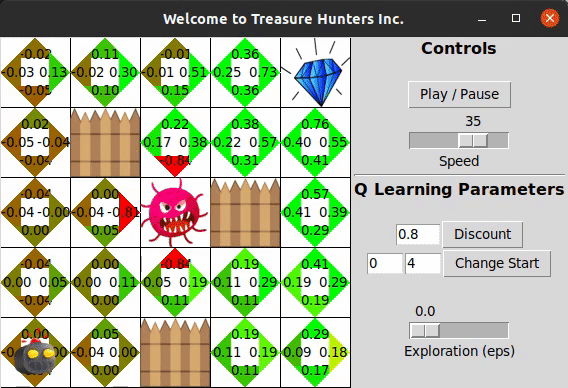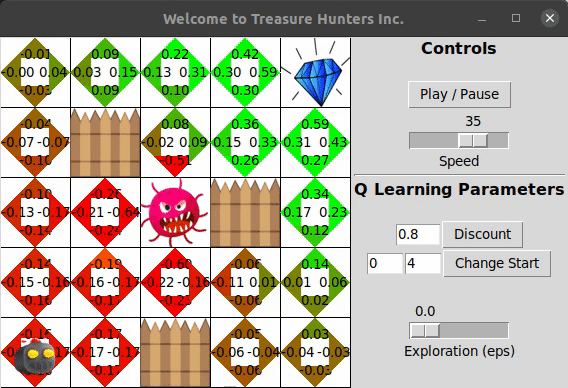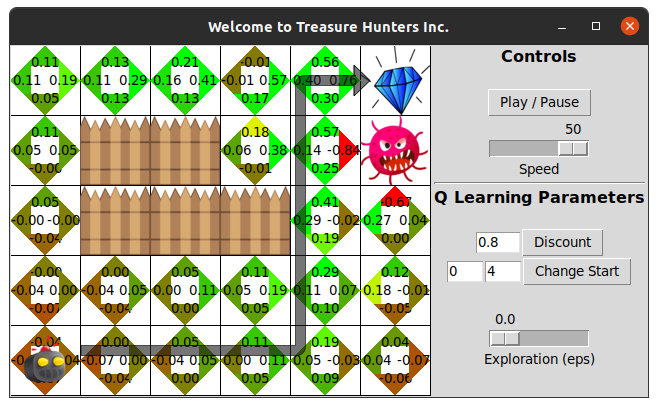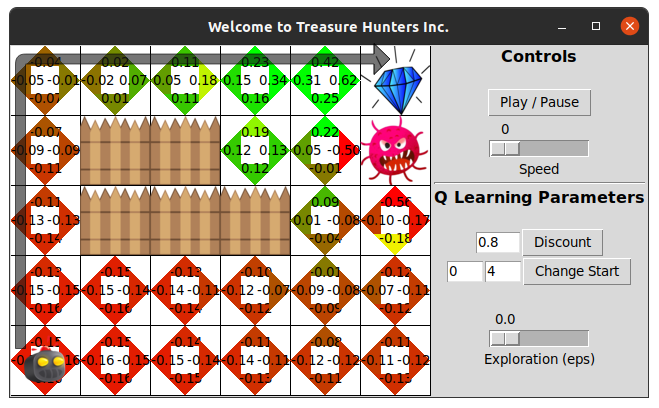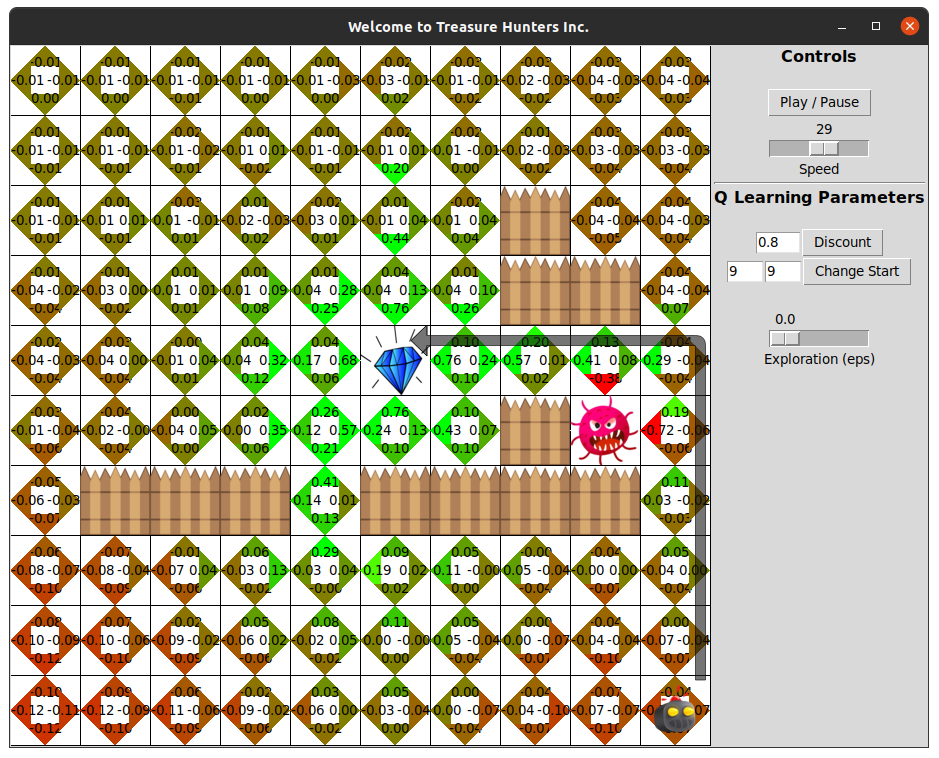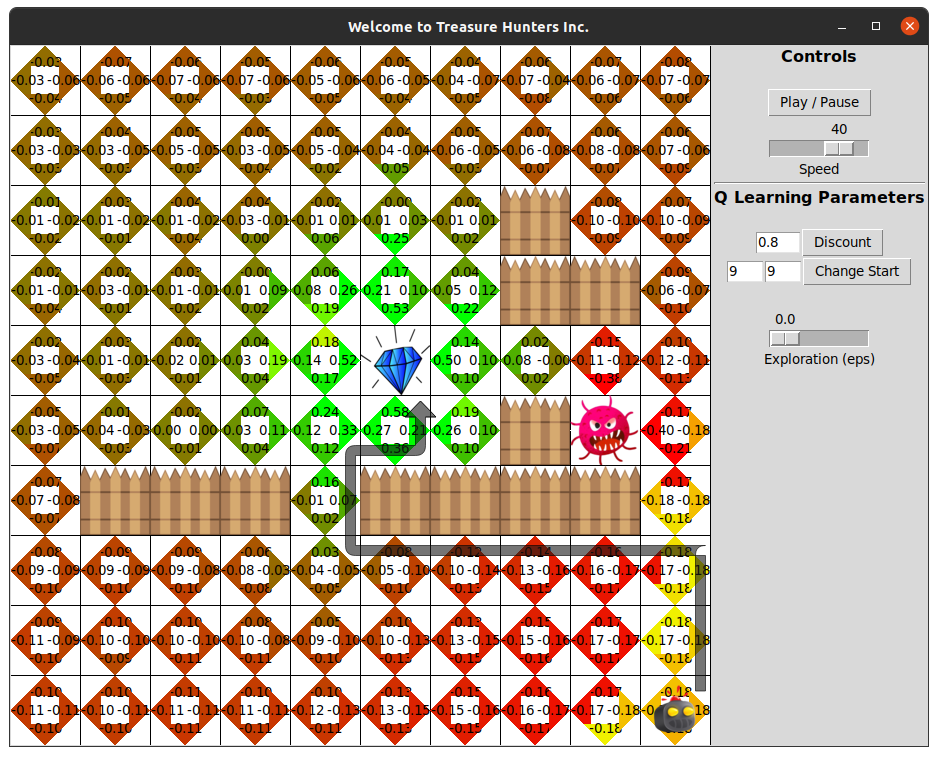-
pip install -r requirements.txt
sudo apt-get install python3-pil python3-pil.imagetk -
The map must be saved as a text file with the following format:
0 0 0 0 3
0 1 1 0 4
0 1 1 0 0
0 0 0 0 0
2 0 0 0 0where, 1 is Wall (or Obstacles), 2 is Agent, 3 is Treasure, 4 is Monster (or Pit)
-
Terminal commands
python3 q_deterministic.py
python3 q_stochastic.py- Grid world GUI
- Create new maps or load stored maps with dynamic grid size
- Embedded controls to change the parameter values such as start point, exploration (eps), discount, and simulation speed
-
R(s): For every action from current state, the agent gets an immediate walk/live reward of -0.05. This ensures that the agent doesn’t keeps on trying a bad action like hitting a wall continuously.
-
Discount (γ) : This defines the portion of the next state reward that the agent gets for a given action. This value is 0.8 (i.e. 80%) for this implementation.
-
T(s, a, s’): T defines the transition model, which is the probability of landing in a new state from current state by taking an action a.
In deterministic learning, the probability of getting into a new state s’ from the current state s by taking the action a is always 1 and is 0 for all other actions.
In stochastic learning, this probability is spread across different actions. For this implementation, probability of s’ from s by taking a is 0.6 while it is 0.1 for the other three actions and 0.1 for staying at the same place.
The above equation gives a new Q value for a given action. When the agent is in the learning phase, a higher weight is given to the new Q values as compared to the previously learned Q value due to high uncertainty. However as the number of iteration increases, the weight of the newer Q values decreases and the weight of the older Q values increases as the uncertainty decreases over time.
The learning rate α which is a function of number of iteration controls the convergence of Q table.
- The total number of episodes or iterations are limited to 10000 by default and can be changed in the program.
- In each episode, the agent starts again after 300 steps.
Epsilon - Probability of taking an action other than optimum action. Choice of actions:
-
Always Greedy: When the value of epsilon is zero, the agent always takes an optimum action from current state. Thus the chances of staying in a local minima is high.
-
Always Random: When the value of epsilon is one, the agent always takes an action which is not optimum. Although the Q table will be updated with the highest reward path, the agent will always keep on exploring without moving on the highest reward path.
-
Softmax Exploration (Simulated Annealing): The Softmax exploration biases the exploration towards higher reward actions. Boltzmann distribution gives a fair estimate of an action in the direction of high reward action using the Q values encountered.
In the current implementation, we have a function to get the current softmax value. However, by default it is disabled to give interactive control of epsilon value to the user in the GUI. In order to switch between softmax policy and manual control epsilon, use one of the following statement in the q_learn method.
epsilon = World.w2.get()
# epsilon = soft_max(current, iter)- Example 1
Deterministic Learning
The agent goes through the shortest path to get more reward, even if it has
a monster along that path. This is because the transition model is such that
the agent will never reach the monster once it has learned the Q values.
Stochastic Learning
We can see that for stochastic version of the above map, the agent chose a
different path because the reward in the previous path (with monster) has been
reduced due to the transition model effect from neighboring states.
- Example 2
Deterministic Learning The agent goes through the shortest path to get more reward, even if it has a monster along that path. This is because the transition model is such that the agent will never reach the monster once it has learned the Q values.
Stochastic Learning
We can see that for stochastic version of the above map, the agent chose a
different path because the reward in the previous path (with monster) has been
reduced due to the transition model effect from neighboring states.





